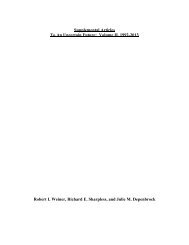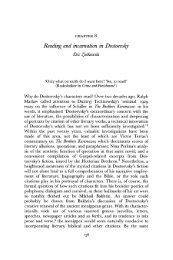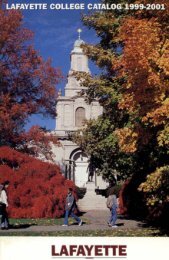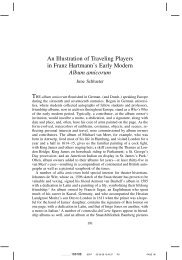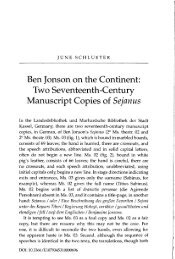Swift's “Skinnibonia”: A New Poem from Lady ... - Lafayette College
Swift's “Skinnibonia”: A New Poem from Lady ... - Lafayette College
Swift's “Skinnibonia”: A New Poem from Lady ... - Lafayette College
You also want an ePaper? Increase the reach of your titles
YUMPU automatically turns print PDFs into web optimized ePapers that Google loves.
334<br />
James Woolley<br />
Second Visit, June-October 1729<br />
4 August 1729<br />
“Robin and Harry.” Swift’s holograph is Forster MS 521 (Victoria and Albert<br />
Museum); the dating is <strong>from</strong> the holograph. First published in Swift’s Works,<br />
XVI (London, 1765).<br />
1729?<br />
“Drapier’s Hill.” First published 30 August 1729 in Fog’s Weekly Journal. In<br />
settling the date of composition, Swift’s poem “A Dialogue between an Eminent<br />
Lawyer and Dr. Swift, Dean of St. Patrick’s” sheds less light than it might at first<br />
appear to do, although it alludes to Swift’s planned house on Drapier’s Hill.<br />
In 1762, when Faulkner first published “A Dialogue,” he dated it “February<br />
1728,” meaning presumably February 1728/9. However, collation makes clear<br />
that in 1762 Faulkner was reprinting “A Dialogue” <strong>from</strong> Deane Swift’s An<br />
Essay upon the Life, Writings, and Character of Dr. Jonathan Swift (London:<br />
Bathurst, 1755), and Deane Swift merely says that the poem was written in<br />
1729 (p. 194).68 One can conclude no more than that “Drapier’s Hill” was<br />
written before 30 August 1729.69<br />
1729<br />
“The Revolution at Market Hill.” First published in Swift’s Works, II (Dublin:<br />
Faulkner, 1735). All Faulkner’s editions say that the poem was written in 1730,<br />
but there is not much to go on other than that it was composed during the<br />
period when Swift still intended to build a house at Market Hill, to be called<br />
Drapier’s Hill. On the assumption that Swift’s decision not to build had been<br />
firmly arrived at by 31 October 1729, the date of “The Revolution at Market<br />
Hill” must be earlier than that. See discussion below, under “The D——’s<br />
Reasons for Not Building at Drapier’s Hill.”<br />
20 September 1729<br />
“A Pastoral Dialogue.” So dated in a contemporary manuscript among the<br />
Portland Literary Manuscripts, University of Nottingham MS PwV 409. Dated<br />
1728 by Faulkner, but the greater specificity of the Portland manuscript, probably<br />
collected by the second Earl of Oxford <strong>from</strong> a knowledgeable source,<br />
68 Williams believes that “A Dialogue” refers to the controversy surrounding “A Libel on D——D——”<br />
and therefore cannot be earlier than 1730 (<strong>Poem</strong>s, ed. Williams, II, 488-89); Davis (pp. 429-30) follows<br />
Williams, but I agree with Rogers that Williams’s reasons are not “conclusive” (<strong>Poem</strong>s, p. 805).<br />
69 I am not listing “To Dean Swift. By Sir Arthur Acheson” (beginning “Good cause have I to sing and<br />
vapour”), since, pace Williams, I see no reason to doubt the attribution that accompanied the poem<br />
when it was first published by Deane Swift in Swift’s Works, XVI (London, 1765). Presumably, it was<br />
written after “Drapier’s Hill” and before “The D——’s Reasons.”



